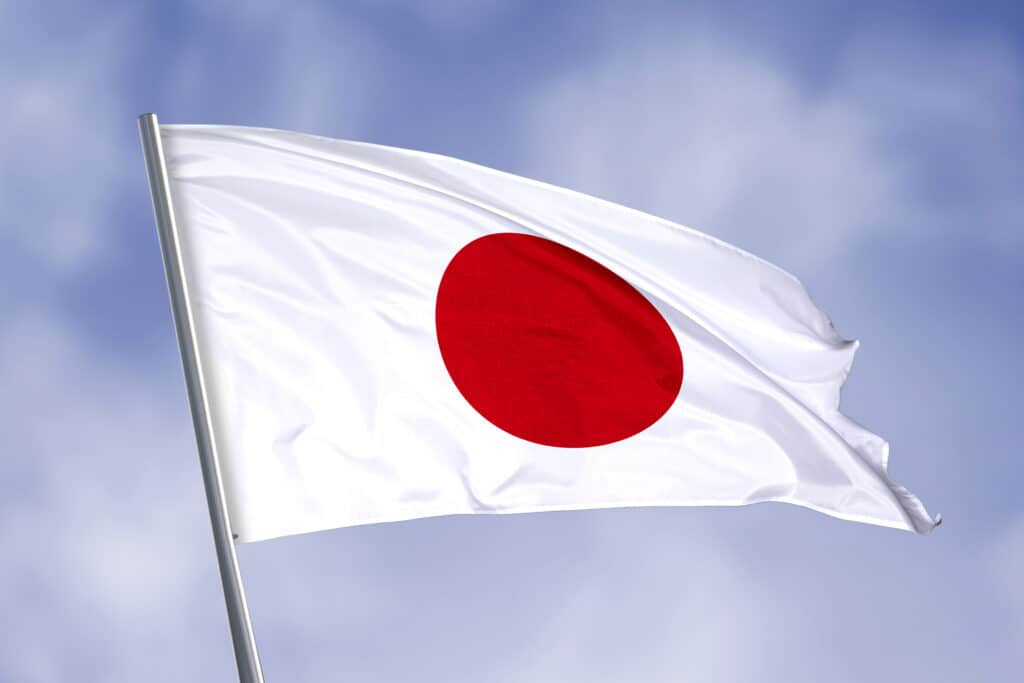The flag of Japan has a red circle in the middle of a rectangular white banner. The official designation of this flag is Nisshoki, which literally translates to “flag of the sun.” It is also known as the Hinomaru, or “circle of the sun,” in Japan. It personifies the nation’s nickname, “Land of the Rising Sun.” The rising sun has had significant symbolic meaning since the early 7th century; however, its precise origin is unknown. In 607, official mail with the signature “from the Emperor of the rising sun” was delivered to the Chinese Emperor Yang of Sui. Continue reading below to learn more about the history of the Japanese flag!
Flag of Japan History

The usage of the sun flag in Japan dates all the way back to the year 1184.
©TuckerBlade/Shutterstock.com
The nation was supposedly founded in the seventh century BC by the sun goddess known as Amaterasu, related to Jimmu, the very first ruler of Japan. Even today, the nation is usually referred to as the “Land of the Rising Sun.” The emperor is still called the “Son of the Sun.” Although there are oral traditions that date back far longer, the usage of a sun flag is first recorded in literature in the year 1184.
The Japanese flag known as the Rising Sun Flag is made up of a crimson disc with sixteen red rays extending from it. The Rising Sun Flag is a representation of the sun, just like the national flag of Japan. However, the Rising Sun Flag differs from the Japanese flag in that it features sun rays, symbolizing how Japan is known as “The Land of the Rising Sun.” The Rising Sun Flag was originally used by the Imperial Japanese Army in 1870. The flag is currently flown by the Japan Maritime Self-Defense Force. The Japan Self-Defense Forces and the Japan Ground Self-Defense Force fly an eight-ray version of it.
The present flag’s design was officially adopted on August 5, 1854, as Japan was beginning to broaden commerce and diplomatic relations with European countries. It has a red disc in the center and a white background. The Nisshoki flag serves as the official national flag of Japan according to the Act on National Flag and Anthem, which passed and came into effect on August 13, 1999. No other national flag had been designated by prior legislation. The official adoption of the national flag by the Diet, or Japanese parliament, formalized the 19th-century flag laws.
Flag of Japan Meaning
The sun is revered in Japanese religion and mythology because of the Emperor. It is thought to be a direct ancestor of Amaterasu, their sun goddess. This divine designation and descent from the main deity of the dominant Shinto religion served as the foundation for the ruling family’s credibility. The nation’s nomenclature and the flag’s design both allude to the sun’s fundamental importance. Emperor Monmu flew a flag with a sun motif at his court for the first time in Japan in 701, according to the antiquarian history book Shoku Nihongi. The Unp-ji Temple in Ksh, Yamanashi, is home to the oldest known flag. It dates back to before the sixteenth century. An outdated rumor claims that Emperor Go-Reizei gave the flag to the shrine in the 11th century.
The Flag of Japan Design and Colors
Two provisions relating to the flag were included in Prime Minister’s Proclamation No. 57, which passed in 1870. The first phrase specified how and by whom the flag was to be flown. The second phrase gave information about the flag’s design. The ratio was seven units wide by ten units long. The dimension of the red disc, which represents the sun, was found to be three-fifths of the hoisted width. The disc was intended to sit in the center, as required by law.

The flag of Japan has a white background with a red circle in the center.
©Tatohra/Shutterstock.com
On October 3 of 1870, laws controlling the merchant flag as well as other military flags were passed. Following the adoption of the Law Regarding the National Flag and National Anthem, the flag’s dimensions were slightly altered. The overall size of the flag was changed to two units in width by three units in length. The red disc’s size remained static, but it was shifted closer to the middle.
The flag of Japan has a white backdrop with a red circle in the center. However, the precise color tones were not included in the 1999 rule. Just the fact that it has a “deep” hue is stated. It was suggested that when addressing the Law Regarding the National Flag and National Anthem, one should either use a brilliant red, also known as “iro” shade, or a color from the spectrum of the Japanese Industrial Standards. The pole that it is officially raised from is made of coarse natural bamboo. The pinnacle on top is a sparkling gold ball.
Flag of Japan Symbolism
The flag’s primary associations in its early years were with ships and Japan’s overseas diplomatic missions. Only gradually did the general population come to accept its usage on land. Older traditions indicate that when the government issued the order, Japanese individuals had to display the flag in their houses for important occasions like holidays and celebrations. The Japanese have a deep and meaningful approach to artistic designs of all kinds. They respect their national flag for its minimalism, striking contrast, and appropriate symbolism. The flag of Japan is portrayed as a symbol of pride and patriotism in the nation.
Up Next:
- The Flag of Lesotho: History, Meaning, and Symbolism
- The Flag of Ghana: History, Meaning, and Symbolism
- The Flag of Djibouti: History, Meaning, and Symbolism
The photo featured at the top of this post is © PX Media/Shutterstock.com
Sources
- Edarabia, Available here: https://www.edarabia.com/japan/flag/
- Voyapon, Available here: https://voyapon.com/japanese-flag-history/
- Japan Gov, Available here: https://www.japan.go.jp/japan/flagandanthem/index.html
Thank you for reading! Have some feedback for us? Contact the AZ Animals editorial team.






